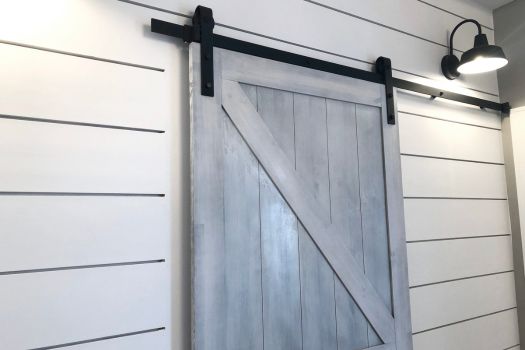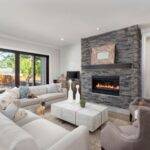The world of interior design never stands still—and neither should you. If you’ve been captivated by the modern farmhouse aesthetic, you’re not alone. It’s charmed homeowners for years with its blend of rustic warmth and minimalist appeal. But lately, something fresh has been quietly taking over, bringing a softer sophistication to the table. We’re at the exciting forefront of home design trends: transition from modern farmhouse to cottage.
This new wave—the modern cottage style—keeps the comfort but trades in the overdone for the intentional. And when it comes to navigating these shifts in both style and property investment, there’s no one better than Robbie English, Broker and REALTOR at Uncommon Realty. Backed by decades of real estate mastery and a nationwide reputation as a speaker and instructor, Robbie and his expert team don’t just help you buy or sell—they help you envision and achieve a lifestyle that matches today’s most compelling design philosophies.

TL;DR – Key Takeaways About Home Design Trends and the Shift from Modern Farmhouse to Cottage
- The transition from modern farmhouse to cottage style leads today’s home design trends with a refined yet cozy aesthetic.
- Modern cottage interiors blend simplicity, vintage flair, natural textures, and curated personal touches.
- Robbie English and his expert team at Uncommon Realty deliver unmatched insight and guidance tailored to your design-forward real estate goals.
- With decades of experience, Robbie is a broker, REALTOR, national real estate speaker, and real estate instructor who teaches agents across the country.
- Choosing Robbie means aligning with a strategic professional who has mastered real estate to elevate your success in today’s evolving housing market.
How We Got Here: From Farmhouse Charm to Cottage Chic
Let’s rewind for a moment. The rise of the modern farmhouse wasn’t an accident. Emerging in the 1990s, this trend combined the softness of shabby chic with utilitarian charm. It leaned into neutral color palettes, reclaimed wood, oversized light fixtures, and the beloved barn door. That look carried us through years of inspiration—elevated by the cultural phenomenon of “Fixer Upper” and the signature style of Texas icons Chip and Joanna Gaines.
By the early 2000s, it had embraced the comfy-cozy of Pottery Barn. By 2013, it welcomed industrial touches—exposed bulbs, raw metals, and repurposed materials. It felt lived-in. It felt homey. But over time, it also became repetitive, even predictable.
Enter the modern cottage.
This next evolution isn’t a dramatic departure; it’s a graceful progression. The home design trends we’re seeing now shift toward a more curated experience. You still get the coziness, but it’s more refined. More thoughtful. Less literal.
The Signature Look: What Makes a Cottage Modern?
This isn’t your grandmother’s cottage, though it nods respectfully to the past. Today’s modern cottage is about balance. Vintage rugs might sit beneath sleek, low-profile furniture. Rustic textures play off smooth surfaces. Soft neutrals dominate, but you’ll also find sage green or inky black used sparingly for depth.
Lighting is important—but less about statement and more about mood. Hand-thrown pottery, layered linens, oil-rubbed bronze, and brushed brass live together comfortably in this new narrative.
The shift from modern farmhouse to cottage isn’t about abandoning comfort—it’s about maturing your aesthetic. Imagine open shelving that’s styled, not cluttered. Furniture that invites you to sink in, but with clean lines and intentional form. Spaces that encourage conversation, without shouting a theme.
The Heart of the Home: Kitchens and Living Spaces That Reflect This Evolution
If the kitchen is the soul of the home, the modern cottage makes it feel personal again. Gone are the all-white, cookie-cutter cabinets and high-gloss counters. In their place? Softly painted cabinetry—think misty blue or muted olive—and handcrafted tiles that feel both humble and luxurious.
Open floor plans are still in demand, but now we’re seeing more delineation between spaces using furniture placement, arched openings, and cozy nooks. Living rooms aren’t just places to sit—they’re curated, layered, and lived-in.
Instead of open-concept everything, it’s now about open flow with cozy definition. Robbie English and his team understand how to spot these value-building details, and can help guide buyers and sellers in making smart choices about how their homes are presented—or what to look for when purchasing a future-forward property.
Why This Shift Matters for Buyers and Sellers
Design is never just about aesthetics. It influences how a home feels—and how it sells. In competitive real estate markets, aligning with home design trends like the transition from modern farmhouse to cottage gives your property an edge.
Buyers today are savvy. They scroll design feeds, they dream in mood boards. They’re looking for authenticity and personality, not staged perfection. Sellers who lean into the modern cottage movement position their homes as relevant, aspirational, and livable.
If you’re buying, these homes tend to hold their appeal longer because they aren’t built around passing fads. Instead, they pull from timeless elements and make them current. With Robbie’s seasoned guidance, buyers can recognize the homes that not only feel right—but make long-term sense.
Making it Yours: Living in the New Cottage Style
Design isn’t a template—it’s a lens. The beauty of the cottage style is its flexibility. You can lean heavily into the vintage, or add subtle touches to your modern space to ease the transition.
This isn’t about gut jobs or major renovations. Sometimes, it’s a matter of swapping shiny fixtures for aged metals, replacing high-gloss cabinets with muted finishes, or incorporating textiles that bring softness to sleek spaces.
![]() Working with Robbie English and his team doesn’t just get you through the transaction. It opens up access to insight you won’t find on a listing page—what changes add value, what to skip, and how to make your home feel both on-trend and uniquely yours.
Working with Robbie English and his team doesn’t just get you through the transaction. It opens up access to insight you won’t find on a listing page—what changes add value, what to skip, and how to make your home feel both on-trend and uniquely yours.
Strategic Real Estate Guidance Backed by Decades of Mastery
Robbie English isn’t just a broker. He’s a strategist, a national voice in real estate, and a trusted instructor to agents across the country. With decades of boots-on-the-ground experience, he’s worked hard to master real estate not for his own sake—but for yours.
When you’re navigating a market shaped by evolving preferences and emerging styles, it pays to have someone who understands not only transactions but design, lifestyle, and the psychology of buyers. Robbie and his team deliver exactly that.
They don’t approach real estate like a script. They treat every client like a strategy. If you’re ready to find a home that reflects today’s home design trends or to position your home as the perfect example of the transition from modern farmhouse to cottage, they’re the team that makes it happen.
Why Robbie English Is the Agent You Want on Your Side
Anyone can show you houses. Not everyone can interpret the subtle shifts in design, buyer behavior, and neighborhood evolution that make or break a deal. Robbie does. And he teaches others how to do it, too.
That kind of expertise is rare—and it’s what sets you up for success. Whether you’re buying your dream home or preparing to list a property, Robbie helps you see around corners. His guidance means fewer missteps, stronger positioning, and smarter decisions.
He’s not following trends. He’s setting the bar higher for what real estate service should be.
Ready to Step Into What’s Next?
Design changes, but the need for expertise stays the same. If you’re feeling inspired by the modern cottage style or curious how the shift from modern farmhouse to cottage could influence your next move, now is the time to act.
Reach out to Robbie English and his team at Uncommon Realty. Let them guide you through the process with precision, care, and a clear vision that aligns with today’s most compelling home design trends. Whether you’re buying, selling, or simply exploring your options, Robbie brings the experience and strategy you need to move forward with confidence.
It’s not just about real estate. It’s about creating a home—and a future—that fits who you are, and who you’re becoming. Let’s get started.




